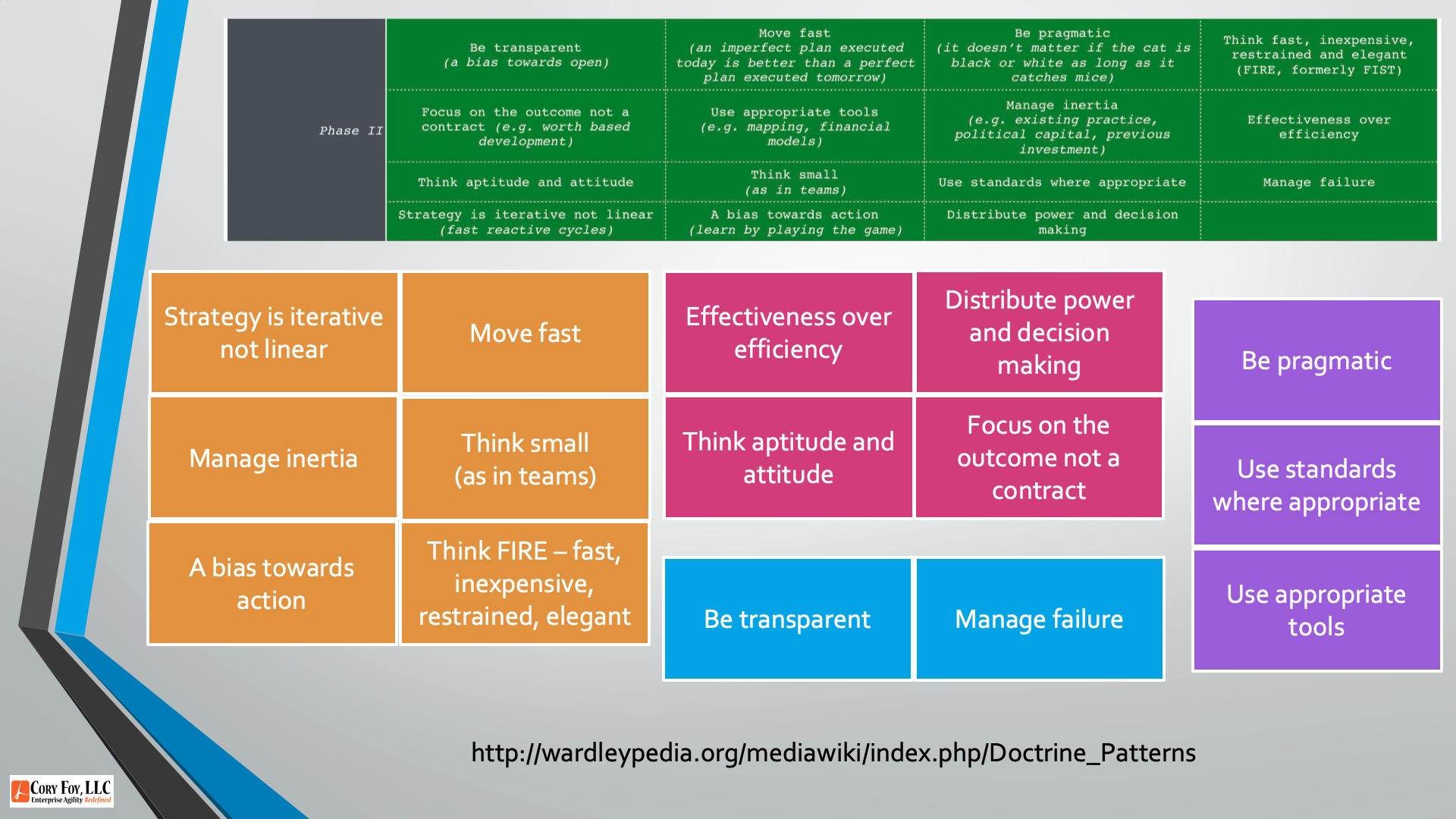Happy Mapping Monday! Today’s #mappingmondays video dives deeper into the four phases of Doctrine and how you can think about them playing together in your organization at each phase. If you’re interested in finding out how to apply this to your organization, don’t hesitate to reach out via Twitter or email hello at coryfoy dot com!
Links:
- Doctrine Patterns
- Doctrine is not a checklist to follow
- Wardley’s Doctrine
Transcript:
Happy Monday! I’m Cory Foy, and welcome to this week’s Mapping Mondays video! So far in this series we’ve talked a lot about mapping as a mechanism for understanding your landscape and discovering where you can make plays and, and have even talked about some of the different types of plays you can make.
However, the capability to make a play is dependent on several factors. The first is the context and landscape – you’re likely not going to have a good play with a first mover advantage if you’re competing in a utilitized component space. But once you’ve understood the types of gameplays that are contextually relevant, we still need the doctrine to be able to execute them.
Simon Wardley defines Doctrine as universally useful patterns that can be applied regardless of context. I like to think of it as the operating model for your organization. In this chart, we can see the doctrine based on varying categories – Communication, Development, Learning, etc.
As part of this chart, Simon suggests coloring in that doctrine based on your assessment of it within your organization. Naturally we are all going to have weak areas, so Simon provides a second view of the doctrine based on varying phases. Let’s take a closer look at these phases.
In Phase 1 we’re establishing our base operating model. We need to know our users so we can focus on user needs. We need to use a systematic method of learning so we have the data to challenge assumptions as well as being able to focus on high situational awareness. We need to use a common language so we can remove bias and duplication. And we need to use the appropriate methods, thinking small – knowing the details about what we’re doing and why we’re doing it.
In Phase 2 we’re establish our capabilities of making gameplays. We know that strategy is iterative, not linear, so we need to manage inertia and bias towards action, moving fast and thinking about small teams operating with FIRE – fast, inexpensive, restrained and elegant. To do this we’re going to need to value effectiveness over efficiency, distributing power and decision making, knowing that it’s not just the aptitude of the teams – but their attitudes towards focusing on the outcomes. We need to be pragmatic, using standards where appropriate, and using the appropriate tools. But ultimately we need to be transparent about our goals, operating methods and direction, as well as manage failure – because when we’re iterating and moving fast, that’s going to happen.
In Phase 3 we’re raising the bar for our teams. From a leadership perspective, we’re committing to directions but being adaptive along the path. We understand strategy is complex, so we think big, being curious and taking appropriate risks to bias towards the new. We need to seek the best we can find, but also be humble – listening to needs, being selfless and standing up for the direction. Leaders need to be the owner of the direction and strategy, setting exceptional standards, but also providing teams with purpose, mastery and autonomy. We’re still looking at the FIRE methods, and we want to continue to do better with less. Part of that is using the data we’ve been gathering to understand how to optimize our flow with Lean Thinking.
Finally, in Phase 4 we’re firing on all cylinders. We’re designing for constant evolution, understanding that there is no core, because everything is evolving, everything is transient. We’re able to not only use appropriate methods, but shift into appropriate cultures – exploring the landscape like Pioneers, establishing footholds in the market like Settlers, and scaling and operationalizing components like Town Planners. We’re listening to our ecosystems, not just visualizing our landscape, but actively understanding how we can exploit the weaknesses of the markets and our competitors.
So as you look at your landscape and gameplays, think about the doctrine that needs to be in place to be successful at making that play. And when you identify weaknesses, focus on improving them. This improvement is a key part of the assessment and maturity models I’ve worked with clients across the globe to implement, and I’m always happy to share more information about Doctrine and other assessment models if you find them useful.
If you do want more information, feel free to reach out on Twitter at @cory_foy or via email at hello at Cory Foy dot com. And as always, thanks for watching and be sure to check out all the Mapping Mondays videos on my site!
Until next week, Happy Mapping!
